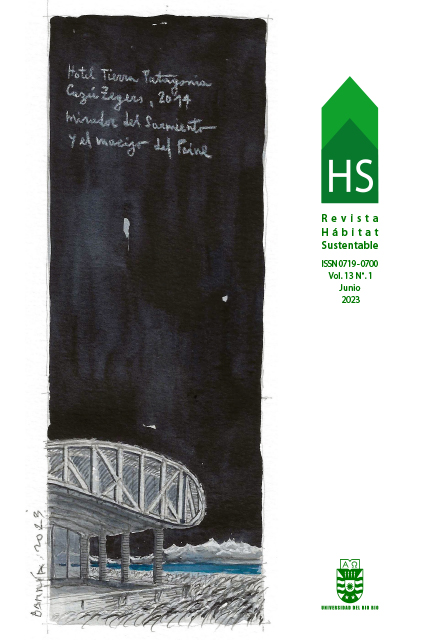Feasibility of the adaptive thermal comfort model under warm sub-humid climate conditions: Cooling energy savings in Campeche, Mexico
DOI:
https://doi.org/10.22320/07190700.2023.13.01.10Keywords:
adaptive thermal comfort, hot sub-humid climate, energy savingsAbstract
The conventional approach to achieve thermal comfort generally focuses on modifying the setpoint temperature in fully air-conditioned buildings. However, the adaptive thermal comfort approach is an alternative that considers the interaction between buildings, the local climate, and the users to allow significant improvements in energy savings. This paper analyzes the feasibility of implementing adaptive thermal comfort strategies, comparing adaptive models based on the ASHRAE 55-2020 Standard and a regional model for the tropical climate typology of Mexico, and contrasting the results with the static approach. Thirteen locations in the State of Campeche were thermally analyzed, seeing that the ventilation strategies are applicable throughout the State and that both models ensure improvements in energy consumption. In addition, the results suggest that it is necessary to develop more local adaptive models to propose strategies with better potential impact in the region.
Downloads
References
ANSI/ASHRAE. (2021). ANSI/ASHRAE Standard 169-2020 - Climatic Design Building Standards. Recuperado de: https://www.ashrae.org/file%20library/technical%20resources/standards%20and%20guidelines/standards%20addenda/169_2020_a_20211029.pdf
ASHRAE. (2020). ASHRAE Standard 55-2020 - Thermal Environmental Conditions for Human Occupancy. Recuperado de: https://www.ashrae.org/file%20library/technical%20resources/standards%20and%20guidelines/standards%20addenda/55_2020_a_20210430.pdf
BIENVENIDO-HUERTAS, D., PULIDO-ARCAS, J. A., RUBIO-BELLIDO, C. & PÉREZ-FARGALLO, A. (2021). Feasibility of adaptive thermal comfort for energy savings in cooling and heating: A study on Europe and the Mediterranean basin. Urban Climate, 36, 100807. DOI: https://doi.org/10.1016/j.uclim.2021.100807
CARLUCCI, S., BAI, L., DE DEAR, R. & YANG, L. (2018). Review of adaptive thermal comfort models in built environmental regulatory documents. Building and Environment, 137, 73-89. DOI: https://doi.org/10.1016/j.buildenv.2018.03.053
HOYT, T., ARENS, E. & ZHANG, H. (2015). Extending air temperature setpoints: Simulated energy savings and design considerations for new and retrofit buildings. Building and Environment, 88, 89-96. DOI: https://doi.org/10.1016/j.buildenv.2014.09.010
HUMPHREYS, M. S., NICOL, J. M. & RAJA, I. A. (2007). Field Studies of Indoor Thermal Comfort and the Progress of the Adaptive Approach. Advances in Building Energy Research, 1(1), 55-88. DOI: https://doi.org/10.1080/17512549.2007.9687269
INEGI. 2022. Aspectos Geográficos: Campeche 2021. Aguascalientes.
JIMENEZ-TORRES, M., BIENVENIDO-HUERTAS, D., MAY TZUC, O., BASSAM, A., RICALDE CASTELLANOS, L. J. & FLOTA-BAÑUELOS, M. (2023). Assessment of climate change’s impact on energy demand in Mexican buildings: Projection in single-family houses based on Representative Concentration Pathways. Energy for Sustainable Development, 72, 185-201. DOI: https://doi.org/10.1016/j.esd.2022.12.012
OROPEZA-PEREZ, I., PETZOLD-RODRIGUEZ, A. H. & BONILLA-LOPEZ, C. (2017). Adaptive thermal comfort in the main Mexican climate conditions with and without passive cooling. Energy and Buildings, 145, 251-258. DOI: https://doi.org/10.1016/j.enbuild.2017.04.031
PÉREZ-FARGALLO, A., BIENVENIDO-HUERTAS, D., RUBIO-BELLIDO, C. & TREBILCOCK, M. (2020). Energy poverty risk mapping methodology considering the user’s thermal adaptability: The case of Chile. Energy for Sustainable Development, 58, 63-77. DOI: https://doi.org/10.1016/j.esd.2020.07.009
RODRÍGUEZ, C. M. & D’ALESSANDRO, M. (2019). Indoor thermal comfort review: The tropics as the next frontier. Urban Climate, 29, 100488. DOI: https://doi.org/10.1016/j.uclim.2019.100488
SALA, M., GALLO, C. & SAYIGH, A. A. M. (1999). Architecture - Comfort and Energy. Elsevier.
SALCIDO, J. C., RAHEEM, A. A. & ISSA, R. R. A. (2016). From simulation to monitoring: Evaluating the potential of mixed-mode ventilation (MMV) systems for integrating natural ventilation in office buildings through a comprehensive literature review. Energy and Buildings, 127, 1008-1018. DOI: https://doi.org/10.1016/j.enbuild.2016.06.054
SÁNCHEZ-GARCÍA, D., BIENVENIDO-HUERTAS, D., PULIDO-ARCAS, J. A. & RUBIO-BELLIDO, C. (2023). Extending the use of adaptive thermal comfort to air-conditioning: The case study of a local Japanese comfort model in present and future scenarios. Energy and Buildings, 285, 112901. DOI: https://doi.org/10.1016/j.enbuild.2023.112901
SÁNCHEZ-GARCÍA, D., RUBIO-BELLIDO, C., MARTÍN DEL RÍO, J. J. & PÉREZ-FARGALLO, A. (2019). Towards the Quantification of Energy Demand and Consumption through the Adaptive Comfort Approach in Mixed Mode Office Buildings Considering Climate Change. Energy and Buildings 187, 173-85. DOI: https://doi.org/10.1016/j.enbuild.2019.02.002
SENER, Secretaria Nacional de Energía. (2021). Comisión Nacional Para el uso Eficiente de la Energía. Infografía Confort Térmico. Recuperado de: https://www.gob.mx/conuee/acciones-y-programas/estadisticas-energeticas-en-las-viviendas-mexicanas
TSOLKAS, C., SPILIOTIS, E., SARMAS, E., MARINAKIS, V. & DOUKAS, H. (2023). Dynamic energy management with thermal comfort forecasting. Building and Environment, 237, 110341. DOI: https://doi.org/10.1016/j.buildenv.2023.110341
YAU, Y. H. & CHEW, B. P. (2012). A review on predicted mean vote and adaptive thermal comfort models. Building Services Engineering Research and Technology, 35(1), 23-35. DOI: https://doi.org/10.1177/0143624412465200
Downloads
Published
How to Cite
Issue
Section
License
Copyright (c) 2023 Oscar May-Tzuc, Mario Antonio Jiménez-Torres, Andrea del Rosario Cruz y Cruz, Román Canul-Turriza, Juan Edgar Andrade-Durán, Felipe Noh-Pat

This work is licensed under a Creative Commons Attribution-ShareAlike 4.0 International License.
The content of articles which are published in each edition of Habitat Sustentable, is the exclusive responsibility of the author(s) and does not necessarily represent the thinking or compromise the opinion of University of the Bio-Bio.
The author(s) conserve their copyright and guarantee to the journal, the right of first publication of their work. This will simultaneously be subject to the Creative Commons Recognition License CC BY-SA, which allows others to share-copy, transform or create new materials from this work for non-commercial purposes, as long as they recognize authorship and the first publication in this journal, and its new creations are under a license with the same terms.











 Scientific Information Program/Concurso Fondos de Publicación de Revistas Científicas 2018/ Proyecto Mejoramiento de Visibilidad de Revistas UBB (Código:FP180007).
Scientific Information Program/Concurso Fondos de Publicación de Revistas Científicas 2018/ Proyecto Mejoramiento de Visibilidad de Revistas UBB (Código:FP180007).





